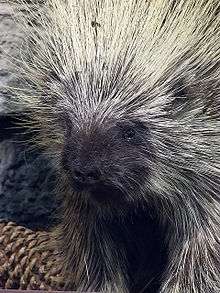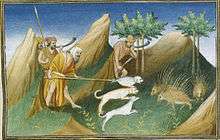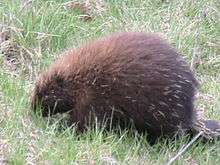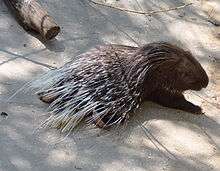Porcupine
| Porcupine | |
|---|---|
 | |
| North American porcupine | |
| Scientific classification | |
| Kingdom: | Animalia |
| Phylum: | Chordata |
| Class: | Mammalia |
| Order: | Rodentia |
| Suborder: | Hystricomorpha |
| Infraorder: | Hystricognathi (part) |
| Families | |
|
Hystricidae (Old World porcupines) | |
Porcupines are rodentian mammals with a coat of sharp spines, or quills, that protect against predators. The term covers two families of animals, the Old World porcupines of family Hystricidae, and the New World porcupines of family Erethizontidae. As mentioned, both families belong to the clade Hystricognathi within the profoundly diverse order Rodentia and display superficially similar coats of quills: despite this, the two groups are distinct from each other and are not closely related to each other within Hystricognathi.
The Old World porcupines live in southern Europe, Asia (western[1] as well as southern), and most of Africa. They are large, terrestrial, and strictly nocturnal. In taxonomic terms, they form the family Hystricidae.
The New World porcupines are indigenous to North America and northern South America. They live in wooded areas and can climb trees, where some species spend their entire lives. They are less strictly nocturnal than their Old World relatives, and generally smaller. In taxonomic terms, they form the family Erethizontidae.
Porcupines are the third-largest of the rodents, behind the capybara and the beaver. Most porcupines are about 25–36 in (64–91 cm) long, with an 8–10 in (20–25 cm) long tail. Weighing 12–35 lb (5.4–15.9 kg), they are rounded, large, and slow. Porcupines occur in various shades of brown, gray, and white. Porcupines' spiny protection resembles that of the unrelated erinaceomorph hedgehogs and Australian spiny anteaters or monotreme echidnas.
Etymology
The name "porcupine" comes from Latin porcus pig + spina spine, quill, via Old Italian—Middle French—Middle English.[2] A regional American name for the animal is quill pig.[3] Similarly, the German name, Stachelschwein, means "thorn-swine" and the Afrikaans name, ystervark, means "iron pig".
Evolution
Fossils belonging to the Hystrix genus date back to the late Miocene of Africa.[4]
Species
Taxonomy
A porcupine is any of 29 species of rodents belonging to the families Erethizontidae (genera: Coendou, Erethizon and Chaetomys) or Hystricidae (genera: Atherurus, Hystrix, and Trichys). Porcupines vary in size considerably: Rothschild's porcupine of South America weighs less than a kilogram (2.2 lb); the crested porcupine found in Italy, Sicily, North Africa, and sub-Saharan Africa can grow to well over 27 kg (60 lb). The two families of porcupines are quite different, and although both belong to the Hystricognathi branch of the vast order Rodentia, they are not closely related.
Old World compared to New World species
The 11 Old World porcupines tend to be fairly large, and have spikes grouped in clusters.
The two subfamilies of New World porcupines are mostly smaller (although the North American porcupine reaches about 85 cm or 33 in in length and 18 kg or 40 lb), have their quills attached singly rather than grouped in clusters, and are excellent climbers, spending much of their time in trees. The New World porcupines evolved their spines independently (through convergent evolution) and are more closely related to several other families of rodents than they are to the Old World porcupines.
Longevity
Porcupines have a relatively high longevity and had held the record for being the longest-living rodent, with one individual living to 27 years,[5] until the record was recently broken by a naked mole-rat living to 28 years.[6]
Diet
The North American porcupine is a herbivore; it eats leaves, herbs, twigs, and green plants such as clover. In the winter, it may eat bark. It often climbs trees to find food.[7]
The African porcupine is not a climber and forages on the ground.[7] It is mostly nocturnal,[8] but will sometimes forage for food in the day. Porcupines have become a pest in Kenya and are eaten as a delicacy.[9]
Quills

Porcupines' quills, or spines, take on various forms, depending on the species, but all are modified hairs coated with thick plates of keratin,[10] and embedded in the skin musculature. Old World porcupines (Hystricidae) have quills embedded in clusters, whereas in New World porcupines (Erethizontidae), single quills are interspersed with bristles, underfur, and hair.
Quills are released by contact or may drop out when the porcupine shakes its body. New quills grow to replace lost ones.[10] It was long believed that porcupines had the ability to project their quills to a considerable distance at an enemy, but this has since been proven to be untrue.[11][12]
Uses
In nature
Porcupines are only occasionally eaten in Western culture, but are very popular in Southeast Asia, particularly Vietnam, where the prominent use of them as a food source has contributed to significant declines in their populations.[13][14][15]
More commonly, their quills and guardhairs are used for traditional decorative clothing. For example, their guardhairs are used in the creation of the Native American "porky roach" headdress. The main quills may be dyed, and then applied in combination with thread to embellish leather accessories such as knife sheaths and leather bags. Lakota women would harvest the quills for quillwork by throwing a blanket over a porcupine and retrieving the quills it left stuck in the blanket.[16]
Porcupine quills have recently inspired a new type of hypodermic needle. Due to backward-facing barbs on the quills, when used as needles, they are particularly good at two things – penetrating the skin and remaining in place.[17] The presence of barbs acting like anchors makes it more painful to remove a quill that has pierced the skin of predator.[10]
In politics
.svg.png)
In 2006, Kevin Breen created a political mascot, a porcupine similar to the animals that represent the two major political parties in the United States; the Democratic Party donkey and the Republican elephant. The porcupine image is often used to represent the U.S. Libertarian party, and even used by some official state Libertarian parties.[18]
State Symbols
The Ashanti state of present-day Ghana have used the Porcupine as their state symbol since its founding.[19] The native word for the Porcupine in Asanti-Twi is "kotoko" which literally means "bend and fight". It refers to the ability of the porcupine to bend and attack its attackers with quills from different angles without losing ground or allowing the enemy to subdue them.[20] This became a military philosophy the Ashanti state adopted which culminated in the use if many military units that attacked from different angles in war. Also, Ashanti warriors were known for crawling on their bellies during gun exchanges as a means of gaining tactical advantage over their opponents on guerrilla maneuverings. The official state soccer team of Ashanti is called Asante Kotoko and it is nicknamed the Porcupine Warriors.[21] The club's emblem is the porcupine which symbolizes the history of the Ashanti state.
Habitat

Porcupines occupy a short range of habitats in tropical and temperate parts of Asia, Southern Europe, Africa, and North and South America. They live in forests and deserts, and on rocky outcrops and hillsides. Some New World porcupines live in trees, but Old World porcupines stay on the rocks. Porcupines can be found on rocky areas up to 3,700 m (12,100 ft) high. They are generally nocturnal but are occasionally active during daylight.

Classification

Porcupines are distributed into two evolutionary independent groups of the order Rodentia, suborder Hystricomorpha.[22][23][24][25][26][27][28][29]
- Infraorder Hystricognathi
- Family Hystricidae: Old World porcupines
- African brush-tailed porcupine, Atherurus africanus
- Asiatic brush-tailed porcupine, Atherurus macrourus
- Crested porcupine, Hystrix cristata
- Cape porcupine, Hystrix africaeaustralis
- Indian porcupine, Hystrix indicus
- Malayan porcupine, Hystrix brachyura
- Himalayan porcupine, Hystrix (brachyura) hodgsoni
- Sunda porcupine, Hystrix javanica
- Sumatran porcupine, Hystrix (Thecurus) sumatrae
- Bornean porcupine, Hystrix (Thecurus) crassispinis
- Philippine porcupine, Hystrix (Thecurus) pumilis
- Long-tailed porcupine, Trichys fasciculata
- Parvorder Phiomorpha sensu stricto
- Family Thryonomyidae: cane rats
- Family Petromuridae: Dassie rats
- Family Bathyergidae: African mole-rats
- Parvorder Caviomorpha
- Superfamily Erethizontoidea
- Family Erethizontidae: New World porcupines
- Brazilian porcupine, Coendou prehensilis
- Bicolored-spined porcupine, Coendou bicolor
- Andean porcupine, Coendou quichua
- Black dwarf (Koopman's) porcupine, Coendou nycthemera (koopmani)
- Rothschild's porcupine, Coendou rothschildi
- Santa Marta porcupine, Coendou sanctemartae
- Mexican hairy dwarf porcupine, Coendou mexicanus
- Paraguaian hairy dwarf porcupine, Coendou spinosus
- Bahia porcupine, Coendou insidiosus
- Brown hairy dwarf porcupine, Coendou vestitus
- Streaked dwarf porcupine, Coendou ichillus
- Black-tailed hairy dwarf porcupine, Coendou melanurus
- Roosmalen's dwarf porcupine, Coendou roosmalenorum
- Frosted hairy dwarf porcupine, Coendou pruinosus
- Stump-tailed porcupine, Coendou rufescens
- North American porcupine, Erethizon dorsatum
- Bristle-spined porcupine, Chaetomys subspinosus (sometimes considered an echimyid)
- Family Erethizontidae: New World porcupines
- Superfamily Cavioidea
- Family Hydrochaeridae: capybara
- Family Caviidae: Guinea-pigs
- Family Dasyproctidae: agoutis and acouchis
- Superfamily Octodontoidea
- Family Abrocomidae: chinchilla-rats
- Family Octodontidae: degus
- Family Ctenomyidae: tuco-tucos
- Family Echimyidae: spiny rats
- Family Myocastoridae: nutrias
- Family Capromyidae: hutias
- Superfamily Chinchilloidea
- Family Chinchillidae: chinchillas and allies
- Family Dinomyidae: pacaranas
- Superfamily Erethizontoidea
- Family Hystricidae: Old World porcupines
See also
References
- ↑ Porcupine on biblehub.com
- ↑ Merriam-Webster Online Dictionary, s.v. "porcupine" . Retrieved March 26, 2015.
- ↑ Oxford English Dictionary, s.v. "quill" . Retrieved July 20, 2010.
- ↑ Barthelmess, E.L. (2006). "Hystix africaeaustralis". Mammalian Species. 788 (788): 1–7. doi:10.1644/788.1.
- ↑ Parker, SB (1990) Grzimek's Encyclopedia of Mammals, vol. 4, McGraw-Hill, New York.
- ↑ Buffenstein, Rochelle; Jarvis, Jennifer U. M. (May 2002). "The naked mole rat—a new record for the oldest living rodent". Science of aging knowledge environment. 2002 (21): pe7. doi:10.1126/sageke.2002.21.pe7. PMID 14602989.
- 1 2 "Porcupines, Porcupine Pictures, Porcupine Facts". National Geographic. Retrieved 2012-02-20.
- ↑ "North American porcupine – Erethizon dorsatum (Linnaeus, 1758)". Natural History Museum of Los Angeles County. Retrieved July 26, 2012.
- ↑ "Porcupines raise thorny questions in Kenya". BBC News. August 19, 2005. Retrieved September 21, 2009.
- 1 2 3 David Attenborough (2014). Attenborough's Natural Curiosities 2. Armoured Animals. UKTV.
- ↑ Encyclopaedia Britannica: Or, A Dictionary of Arts, Sciences, and Miscellaneous Literature, Enlarged and Improved. Archibald Constable. 1823. pp. 501–.
- ↑ Shepard, Thomas Goodwin (1865). The natural history of secession. Derby & Miller. pp. 78–.
- ↑ "Wild Southeast Asian porcupines under threat due to illegal hunting, researchers find". Sciencedaily.com. 2010-08-25. Retrieved 2012-02-20.
- ↑ Brooks, Emma G.E.; Roberton, Scott I.; Bell, Diana J. (2010). "The conservation impact of commercial wildlife farming of porcupines in Vietnam". Biological Conservation. 143 (11): 2808. doi:10.1016/j.biocon.2010.07.030.
- ↑ Ettinger, Powell (2010-08-30). "Wildlife Extra News – Illegal hunting threatens Vietnam's wild porcupines". Wildlifeextra.com. Retrieved 2012-02-20.
- ↑ "Lakota Quillwork Art and Legend". Retrieved 29 June 2013.
- ↑ Cho, W. K.; Ankrum, J. A.; Guo, D.; Chester, S. A.; Yang, S. Y.; Kashyap, A.; Campbell, G. A.; Wood, R. J.; Rijal, R. K.; et al. (2012). "Microstructured barbs on the North American porcupine quill enable easy tissue penetration and difficult removal". Proceedings of the National Academy of Sciences. 109 (52): 21289. doi:10.1073/pnas.1216441109.
- ↑ http://ny.lp.org/
- ↑ http://africaonwheels.pbworks.com/w/page/1491864/Ashanti%20Okyeame
- ↑ http://ir.knust.edu.gh/bitstream/123456789/374/1/fulltxt.pdf
- ↑ https://books.google.com.br/books?id=6NQaBgAAQBAJ&pg=PT58&lpg=PT58&dq=asante+kotoko+porcupine+warriors&source=bl&ots=4LH8CpDche&sig=vdVk55Hi88ZqCrhhcmN9iH_aSpo&hl=en&sa=X&ved=0ahUKEwizz9Wu0LrQAhXKlZAKHSRSDj8Q6AEIPzAG#v=onepage&q=asante%20kotoko%20porcupine%20warriors&f=false
- ↑ Huchon D., Catzeflis F. & Douzery E. J. P. (2000). "Variance of molecular datings, evolution of rodents, and the phylogenetic affinities between Ctenodactylidae and Hystricognathi". Proc. R. Soc. Lond. B. 267 (1441): 393–402. doi:10.1098/rspb.2000.1014. PMC 1690539
 . PMID 10722222.
. PMID 10722222. - ↑ Murphy W. J., Eizirik E., Johnson W. E., Zhang Y. P., Ryder O. A. & O'Brien S. (2001). "Molecular phylogenetics and the origins of placental mammals". Nature. 409 (6820): 614–618. doi:10.1038/35054550. PMID 11214319.
- ↑ Huchon D., Chevret P., Jordan U., Kilpatrick C. W., Ranwez V., Jenkins P. D., Brosius J. & Schmitz J. (2007). "Multiple molecular evidences for a living mammalian fossil". Proc. Natl. Acad. Sci. USA. 104 (18): 7495–7499. doi:10.1073/pnas.0701289104. PMC 1863447
 . PMID 17452635.
. PMID 17452635. - ↑ Blanga-Kanfi S., Miranda H., Penn O., Pupko T., DeBry R. W. & Huchon D. (2009). "Rodent phylogeny revised: analysis of six nuclear genes from all major rodent clades". BMC Evol. Biol. 9: 71. doi:10.1186/1471-2148-9-71. PMC 2674048
 . PMID 19341461.
. PMID 19341461. - ↑ Churakov G., Sadasivuni M. K., Rosenbloom K. R., Huchon D., Brosius J. & Schmitz J. (2010). "Rodent evolution: back to the root". Mol. Biol. Evol. 27 (6): 1315–1326. doi:10.1093/molbev/msq019. PMID 20100942.
- ↑ Meredith R. W., Janecka J. E., Gatesy J., Ryder O. A., Fisher C. A., Teeling E. C., Goodbla A., Eizirik E., Simao T. L., Stadler T., Rabosky D. L., Honeycutt R. L., Flynn J. J., Ingram C. M., Steiner C., Williams T. L., Robinson T. J., Burk-Herrick A., Westerman M., Ayoub N. A., Springer M. S. & Murphy W. J. (2011). "Impacts of the Cretaceous terrestrial revolution and KPg extinction on mammal diversification". Science. 334 (6055): 521–524. doi:10.1126/science.1211028. PMID 21940861.
- ↑ Fabre P.-H., Hautier L., Dimitrov D. & Douzery E. J. P. (2012). "A glimpse on the pattern of rodent diversification: a phylogenetic approach". BMC Evol. Biol. 12: 88. doi:10.1186/1471-2148-12-88. PMC 3532383
 . PMID 22697210.
. PMID 22697210. - ↑ Upham N. S. & Patterson B. D. (2012). "Diversification and biogeography of the Neotropical caviomorph lineage Octodontoidea (Rodentia: Hystricognathi)". Mol. Phylogenet. Evol. 63 (2): 417–429. doi:10.1016/j.ympev.2012.01.020. PMID 22327013.
External links
- Wildlife Conservation: Porcupine African Wildlife Foundation
- "Resource Cards: What About Porcupines?" Pacific Northwest National Laboratory
- Porcupine control in the western states University of North Texas Digital Library
- The Complete Resource To Keeping Porcupines As Pets
